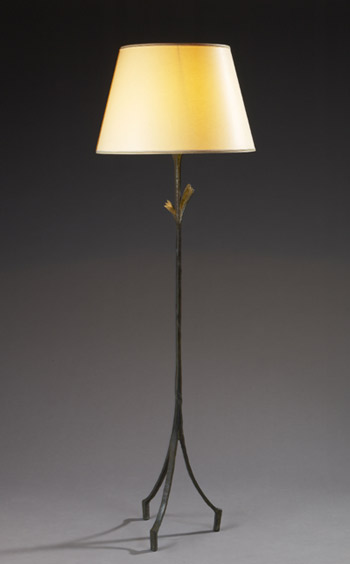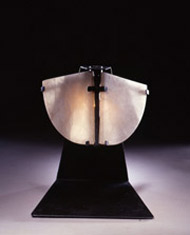The most somber place is always under the lamp according to a Chinese proverb. The exhibition of the galerie De Vos shows that this utilitarian object, which underwent a revolution when electricity appeared, was fertile ground for experiments by the creators of the XXth century. Aside from the specialized decorators, it also inspired figures such as Giacometti or Le Corbusier.
Histories of lamps
These lamps tell us stories of our own. Whether objects of art, or objects without importance… little does it matter. It is the expression of each one, first passing through their silence, then by their darkness. The electric light accentuates their forms, gives them life and dotes them with symbolic riches that will converge over the century, according to the influences of the different decorative styles. «Mr. Thomas Alva Edison, forgive us our lampshades», Ingo Maurer used to write, while recognizing their utility and their charm.
In order to «put a shade over a lamp» what could be better than a piece of cloth or of parchment?
The strength of all of these poets of light resides in the audacity of their innovations.
Illustration, left: MARTIN & GARETTO for DAMON Editor Nickel-Plated Metal Modernist Standing Lamp on a stepped circular base. Tubular standart and spherical swivelling shade. Circa 1930. Height: 2/5 ft Diameter of the base: 13 3/4 in
The UAM spirit
In 1998, the first presentation of «Imagine light» focused in particular on the work of Jean-Michel Frank, the apostle of a pure decoration close to asceticism, and his friends Alberto and Diego Giacometti. This new event does not forsake them, but rather underlines the modernist character of some of their contemporaries such as Pierre Chareau, the author of the famous Maison de verre on rue Saint-Guillaume, who not only collaborated with Jean Lurçat on the tapestries but on Marcel L'Herbier's movie sets as well. Le Corbusier, Lacroix, Bagge, Martin, Garetto, Dourgnon and Sornay are other major names, next to those of Legrain and of Eileen Gray. The UAM (Union des Artistes Modernes) spirit is everywhere, underlining the roots of past and contemporary design.
Illustration, right: PIERRE CHAREAU (1883 - 1950). Table lamp called “Masque”, made of a triangular metal strip and two alabaster quarter circles. The alabaster shades are lightly held by four metallic clips and pivot laterally. Height: 11.3/5 in Width: 10 in Depth: 8 2/5 in
From Le Chevallier to Matégot
The aim of the exhibition is also to specify that during a same period, and more particularly in between 1920 and 1940, where the gallery made a reputation for itself, artists as talented and different as Ruhlmann, Desny or Jacques Le Chevallier (1896-1987), who became master glassier in the workshop of Louis Barillet, who collaborated with Mallet-Stevens in building villa Noailles in Hyères and played a fundamental role after the war in the rebirth of sacred art. They all found a way to express themselves simultaneously, without worrying about one another, often respecting one another and even understanding tacitly the opposite intellectual development. The exhibition touches a summit in the creations by Mouille, Matégot, Guariche and Lebovici.
To see more illustrations, click on VERSION FRANCAISE at the top of this page
|










